Meet A Real Biochemist and Biophysicist
Have you ever wondered why someone becomes a biochemist or a biophysicist, or how to find a career in both fields at the same time?
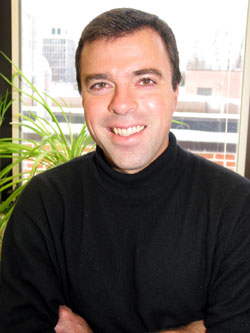
Peter Bandettini, Ph.D., is Director of the Functional Magnetic Resonance Facility and Chief of the Unit on Functional Imaging Methods at the National Institute of Mental Health (NIMH). In the interview below, he shares some thoughts on what motivates him and what it's like working at the NIH IRP.
1. I chose this career because...
I chose to become a biophysicist because since I was about 12 years old, I have been fascinated by human thought and behavior. As I got older, I realized that the mysteries of human behavior lie in understanding our brains – the most complex system known to man. I became not only fascinated with human brain function, but also convinced that sciences such as physics, mathematics, and chemistry were ultimately the most powerful in shedding light on brain function.
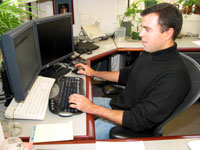
My father was my first major influence. He was always interested in brain function as well. While obtaining his law degree, he obtained a masters degree in psychology. He instilled in me a fascination with the human brain. He inspired me to pursue a career that would be most fulfilling. By example, he was trained as a lawyer, and chose to become a teacher because that is what fulfilled him most.
College and a Lucky Break
By college, I tried to integrate my desire to become an expert in one of the sciences (physics) with my desire to understand the workings of the human brain. In graduate school, I joined a Biophysics program and was introduced to Magnetic Resonance Imaging (MRI) – a relatively new technique for imaging the human brain noninvasively. In 1991, I became very lucky. I was working with a physicist at my graduate school who implemented a fast MRI method - a revolutionary technique. We performed an imaging experiment that showed the activation of the human motor cortex as the subject (myself) tapped his fingers. It worked, and we were the first to publish a paper in a major scientific journal using this technique. Since then, thousands of papers using this technique have been published.
A Great Mentor and Friend
My mentor in graduate school was, interestingly, a fellow graduate student. He was one of the most unique individuals that I have ever known. His combination of brilliance, industriousness, focus, balance, and patience was truly inspiring. He transformed the imaging technique at our graduate school to do functional MRI. I have him to thank for essentially my entire career.
Education
- Bachelors of Science, Physics, Marquette University
- Doctor of Philosophy, Biophysics, Medical College of Wisconsin
- Post-doctoral training, Massachusetts General Hospital and Harvard University
2. My typical workday involves...
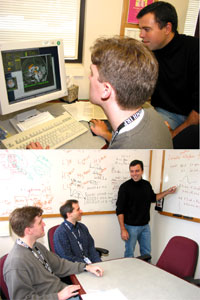
Dr. Bandettini reviews research results with a post-doc (upper photo), and presents his latest findings to colleagues (lower photo).
My typical workday responsibilities revolve around the use and function of the MRI scanner. I work in a very unique place - The National Institutes of Health. This is a government institution devoted to bettering the health of everyone in the country. I work specifically with the institutes that focus on human brain function, primarily the National Institute of Mental Health (NIMH), and the National Institute of Neurological Disorders and Stroke (NINDS).
Primary Responsibilities
- Ensure that the MRI scanners devoted to functional MRI perform well for the 150 researchers who use them
- Carry out scientific research that involves making the technique of functional MRI even more powerful. I try to increase the temporal resolution, spatial resolution, and interpretability of the technique. By manipulating and better defining these MRI capabilities, researchers can ask better questions and make more discoveries about brain function.
Other Daily Activities
- Management of a research laboratory
- Meet with my post docs, students and other staff to discuss their research
- Review papers submitted to scientific journals
- Presentations to other professionals about my research
- Organize discussions, presentations, and journal clubs – researchers who use functional MRI can share research findings and stay up-to-date on related published literature
Diverse Roles
I am mentor, speaker, organizer, manager, and a creative explorer for the lab. My job not only requires the ability to think clearly, critically and creatively, but also requires people skills. I am constantly interacting with many different people everyday. My job also requires working long hard hours – up to 15 hours a day at times.
Equipment I Use:
The primary piece of equipment I use in my job is the 3 Tesla human MRI scanner, a 3 million dollar instrument. It actually measures radio frequency waves that are emitted by the human body. In addition, I rely heavily on many different types of computers for processing data, interacting with the subjects in the scanner, and basic office functions.
3. What I like best/least about my work...
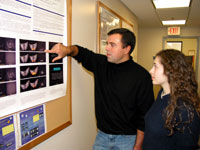
Dr. Bandettini explains his research to a student who works in his lab. He often prepares such posters for presentations at major conferences.
What I like best about my work is that it is at the cutting-edge of our understanding. I am constantly thinking of ways to improve things and ask better questions. The challenge is stimulating.
What I like least about my work is the more mundane things I must do like write memos, and answer emails. Also, I can work for months or years on a problem and not come up with a solution. This can be frustrating at times, but what keeps me going is that inevitably something new is always discovered. It’s only a matter of time if one works intelligently.
4. My career goals are...
My career goal is to further advance and expand the usability and functionality of the MRI technique. Also, I would like to further our understanding of the brain’s function and its relation to human behavior.
5. When I’m not working, I like to...
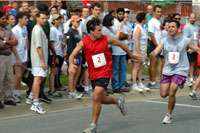
Peter Bandettini passes the baton at the 2003 NIH Relay Challenge.
When I’m not working, I like to run. I run about 5 miles each day. I ran track and cross country all through college. I even had a scholarship to do this. Recently, I participated in the NIH Relay Challenge. I also enjoy playing ultimate Frisbee, hiking, biking, watching movies, listening to music, playing chess and reading.
One of the major perks of being in science is that scientific meetings are usually held in very interesting places. Through work, I have traveled all over the world. I’ve been to Europe over 20 times, Australia over 5 times, and Asia about 5 times. I still love traveling.
6. Combining my passions to find my place...

Peter Bandettini cooks over an open fire while camping at a remote beach in Kauai (upper photo) and takes a break on a mountain peak while hiking in southern Poland (lower photo).
My career path was created when I finally realized what motivated me. First, I was absolutely committed to understanding the human brain. Likewise, I was committed to increasing my knowledge of science and implementing the scientific method. Ultimately, I decided to integrate these two passions, and then be observant of whatever pertinent opportunities presented themselves.
I was lucky to be in the right place at the right time when I started using functional MRI. If I had not been looking for this opportunity, I might have missed my lucky break. So like my father, I believe it is very important to discover what makes you happy and fulfilled. Work hard, look for opportunities, and don’t hesitate to pursue your interests. It is always a comfort to know that your efforts are leading you ever closer to the realization of your goals. My career path started in grade school, and continues even today as I still make big choices regarding what I want to do.
Related Blog Posts
This page was last updated on Wednesday, July 5, 2023
